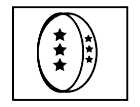Coulomb's law for electric charges, most closely resembles
The law of conservation of momentum
The law of conservation of energy
The law of conversvation of charge
Newton's law of gravitation
The correct Answer is:D
To solve the question regarding which law Coulomb's law for electric charges most closely resembles, we can follow these steps:
1. Understand Coulomb's Law:
Coulomb's law states that the electric force F between two point charges Q1 and Q2 is given by the formula:
F=kQ1Q2r2
where k is Coulomb's constant and r is the distance between the charges.
2. Understand Newton's Law of Gravitation:
Newton's law of gravitation states that the gravitational force F between two masses M1 and M2 is given by:
F=GM1M2r2
where G is the gravitational constant and r is the distance between the masses.
3. Compare the Two Laws:
Both laws describe a force that is:
- Directly proportional to the product of two quantities (charges in Coulomb's law and masses in Newton's law).
- Inversely proportional to the square of the distance between them.
4. Identify the Similarities:
If we replace the charge Q with mass M and the constant k with G, we can see that the structure of both equations is similar:
F∝Q1Q2r2andF∝M1M2r2
This indicates that Coulomb's law and Newton's law of gravitation have a similar mathematical form.
5. Conclusion:
Therefore, we conclude that Coulomb's law for electric charges most closely resembles Newton's law of gravitation.
Final Answer:
Coulomb's law for electric charges most closely resembles Newton's law of gravitation.
Coulomb's law states that the electric force F between two point charges Q1 and Q2 is given by the formula:
F=kQ1Q2r2
where k is Coulomb's constant and r is the distance between the charges.
Newton's law of gravitation states that the gravitational force F between two masses M1 and M2 is given by:
F=GM1M2r2
where G is the gravitational constant and r is the distance between the masses.
Both laws describe a force that is:
- Directly proportional to the product of two quantities (charges in Coulomb's law and masses in Newton's law).
- Inversely proportional to the square of the distance between them.
If we replace the charge Q with mass M and the constant k with G, we can see that the structure of both equations is similar:
F∝Q1Q2r2andF∝M1M2r2
This indicates that Coulomb's law and Newton's law of gravitation have a similar mathematical form.
Therefore, we conclude that Coulomb's law for electric charges most closely resembles Newton's law of gravitation.
Coulomb's law for electric charges most closely resembles Newton's law of gravitation.
Topper's Solved these Questions
- BOOK - NARAYNACHAPTER - ELECTRIC CHARGES AND FIELDSEXERCISE - EXERCISE -1 (H.W)27videos
ELECTRIC CHARGES AND FIELDS
- BOOK - NARAYNACHAPTER - ELECTRIC CHARGES AND FIELDSEXERCISE - EXERCISE -2 (C.W.)39videos
ELECTRIC CHARGES AND FIELDS
- BOOK - NARAYNACHAPTER - ELECTRIC CHARGES AND FIELDSEXERCISE - C.U.Q81videos
ELECTRIC CHARGES AND FIELDS
- BOOK - NARAYNACHAPTER - DUAL NATUREEXERCISE - LEVEL-II (H.W)17videos
DUAL NATURE
- BOOK - NARAYNACHAPTER - ELECTRO MAGNETIC INDUCTIONEXERCISE - Level-II (H.W)23videos
ELECTRO MAGNETIC INDUCTION
Similar Questions
Knowledge Check
- Question 1 - Select One
Coulomb's law for the force between electric charges most closely resembles with
ALaw of conservation of energyBNewton's law of gravitationCNewton's second law of motionDThe law of conservation of charge. - Question 2 - Select One
Coulomb's law is valid for
Acharged particles separated by atomic distances (10−11m) .Bcharged particles separated by atomic distances (10−15m) .Ccharged as well as uncharged particles separated by any distances.Dcharged particles separated by any distance. - Question 3 - Select One
Coulomb's law is restricted to charged rods and balls only. This statement is
AtrueBfalseCoften trueDunpredictable
Does Coulomb's law of electric force obey Newton's third law of motion ?
View SolutionWrite the expression for Coulomb's law for force between two charged particles in MKS system and CGS system
View SolutionChoose the option that most closely resembles the mirror image of the given figure.
 View Solution
View SolutionAccording to Coulomb's law, the electrostatic force between two charges is
View SolutionCoulomb's law is analogous to
View Solution

